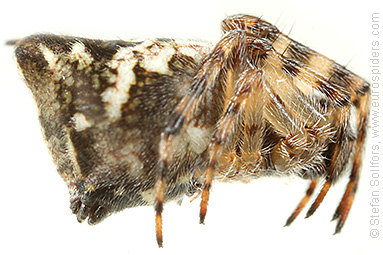References
Blackledge, T.A. and J.W. Wenzel. 1998. Do stabilimenta in orb webs attract prey or defend spiders? Behavioral Ecology 10:372-276.
Blackledge, T.A., A. Danielson-François, C. Dondalel, M. Draney and B. Patrick. 2005. The University of Akron Field Station. <URL:http://www3.uakron.edu/biology/blackledge/bath_spiders.htm>. Accessed 22 April 2014.Blamires, S.J. 2010. Nutritional implications for sexual cannibalism in a sexually dimorphic orb web spider. Austral Ecology 36:389-394.
BugGuide. 2012. <URL: http://bugguide.net/node/view/1989#synonyms >. Accessed 14 April 2014.
BugGuide. 2012.
<URL:
Campbell et al. 2008. An introduction to animal diversity. Pages 686-687 in Beth Wilbur, editor. Biology. Pearson Education Inc., San Francisco, California, USA.
Catalogue of Life: 2014 Annual Checklist. 2014.
Chou, I.C., P.H. Wang, P.S. Shen and I.M. Tso. 2005. A test of prey attracting and predator defense functions of prey carcass decorations built by Cyclosa spiders. Animal Behavior 65: 1055-1061.
Defenders of Wildlife. n.d. <URL:http://www.defenders.org/forest/types-forests>. Accessed 15 April 2014.
Dudic, B.D., V.T. Tomic and L.R. Lucic. 2011. Trochobothrial patterns during postembryonic development of Cyclosa conica (Pallas, 1772) (Araneae, Araneidae). Archives of Biological Sciences 2:441-447.
The Economist. 2003. <URL:http://www.economist.com/node/1875197>. Accessed 20 March 2014.
Encyclopedia of Life. n.d. <URL: http://eol.org/pages/1194900/details>. Accessed 22 March 2014.
Huyett, E., M. Cegelski, N. Crabbs and M. Bowman. 2004. Comparison of wildlife visits to wooded and edge habitats along warm spring. Journal of Ecological Research 6:29-34.
Kervyn, T., M.C. Godin, R. Jocque, P. Grootaert and R. Libois. 2012. Web building spiders and blood-feeding flies as prey of the notch-eared bat (Myotis emarginatus). Belgian Journal of Zoology 142:59-67.
Keswani, S. 1963. Revision of spiders from the genus Cyclosa (Araneae: Araneidae) with description of two new species and the first record of male of C. moonduensis. Indian Society of Arachnology n.v.:61-80.
Korenko, S., E. Kula, V. Šimon, V. Michalková and S. Pekar. 2011. Are arboreal spiders associated with particular tree canopies? North-Western Journal of Zoology 7: 261-269.
Merriam-Webster Dictionary. 2014.
<URL:
Online Etymology Dictionary. n.d. <URL:http://www.etymonline.com/index.php?l=c&p=82&allowed_in_frame=0>. Accessed 24 April 2014.
Opell, B.D. 2001. Estimating the stickiness of individual adhesive capture threads in spider orb webs. Journal of Arachnology 30:494-502.
Pearcy, M., O. Hardy and S. Aron. 2006. Thelytokous parthenogenesis and its consequences on inbreeding in an ant. Heredity 96:377-382.
Pomeroy, R. 2013. Real Clear Science. <URL: http://www.realclearscience.com/blog/2013/02/spiders-their-amazing-hydraulic-legs-and-genitals.html>.
Rittschof, C.C., S.A. Hilber, M.S. Tudor and C.M. St. Mary. 2011. Modeling male reproductive strategies and optimal mate number in an orb-web spider. Behavioral Ecology 23:1-10.
Save Nature. 2010.
<URL:
http://www.savenature.org/grabfile/438.pdf>.
Stefanini, A. and O. Duron. 2012. Exploring the effect of the Cardinium endosymbiont on spiders. Journal of Evolutionary Biology: 2-10
Texas A&M Agrilife Extension. n.d. <URL:http://insects.tamu.edu/fieldguide/orders/non_insect/araneae.html>. Accessed 14 April 2014.
Tree of Life Web Project. 1995. <URL:http://tolweb.org/Arachnida>. Accessed 15 April 2014.
Tso, I.M. 1998. Stabilimentum-decorated webs spun by Cyclosa conica (Araneae-Araneidae trapped more insects than undecorated webs. Journal of Arachnology 26:101-105.
University of California Museum of Paleontology. n.d. <URL: http://www.ucmp.berkeley.edu/exhibits/biomes/forests.php#temperate>. Accessed 22 April 2014.
University of Illinois. n.d. <URL:
http://www.uni.illinois.edu/~dstone/arthropods2002/chelicerata/arachnida/Order%20Araneida/Familyaraneidae.htm>.
Accessed 20 April 2014.
Vera, I.D., V.M. Fleming, E.J. Feil and A.J. Breeuwer. 2012. Diversity and recombination in Wolbachia and Cardinium from Bryobia spider mites. Biomedical Microbiology 12:1-15
Weihmann, T., M. Günther and R. Blickhan. 2012. Hydraulic leg extension is not necessarily the main drive in large spiders. The Journal of Experimental Biology 215:578-583.

